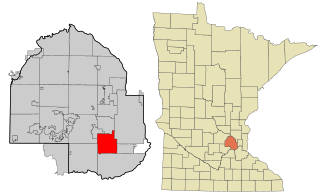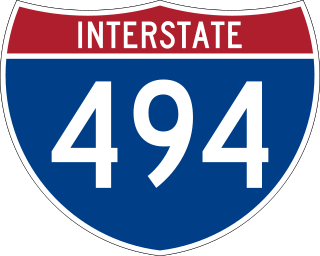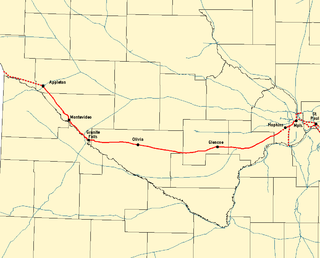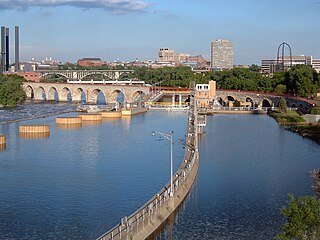
Edina is a city in Hennepin County, Minnesota, United States and a first-ring suburb of Minneapolis. The population was 53,494 at the 2020 census, making it the 18th most populous city in Minnesota.

The Northstar Line is a commuter rail route in the US state of Minnesota. Northstar runs 40 miles (64 km) from Big Lake to downtown Minneapolis at Target Field using existing track and right-of-way owned by the BNSF Railway. Passenger service began on November 16, 2009. The rail line serves part of the Northstar Corridor between Minneapolis and St. Cloud. Planning for the line began in 1997 when the Northstar Corridor Development Authority (NCDA) was formed. The corridor is also served by Interstate 94 and U.S. Highway 10. In 2022, the system had a ridership of 77,100, or about 300 per weekday as of the third quarter of 2023.
Metro Transit is the primary public transportation operator in the Minneapolis–Saint Paul area of the U.S. state of Minnesota and the largest operator in the state. Although Metro Transit is one of the smallest transit systems for a large metropolitan area in the United States, it has previously been ranked as one of the best. In 2022, the system had a ridership of 38,794,700, or about 138,800 per weekday as of the third quarter of 2023.

Interstate 494 (I-494) is an auxiliary Interstate Highway making up part of a beltway of I-94, circling through the southern and western portions of the Minneapolis–Saint Paul metropolitan area in Minnesota. The 42.94-mile (69.11 km) road is coupled with I-694 at each end and composes more than half of the major beltway of the region. I-694/I-494 also act as loop routes for I-35E and I-35W.

Saint Paul Union Depot is a historic railroad station and intermodal transit hub in the Lowertown neighborhood of Saint Paul, Minnesota. It serves light rail, intercity rail, intercity bus, and local bus services.

The Soo Line Railroad is one of the primary United States railroad subsidiaries for the CPKC Railway, one of six U.S. Class I railroads, controlled through the Soo Line Corporation. Although it is named for the Minneapolis, St. Paul and Sault Ste. Marie Railroad (MStP&SSM), which was commonly known as the Soo Line after the phonetic spelling of Sault, it was formed in 1961 by the consolidation of that company with two other CPKC subsidiaries: The Duluth, South Shore and Atlantic Railway, and the Wisconsin Central Railway. It is also the successor to other Class I railroads, including the Minneapolis, Northfield and Southern Railway and the Chicago, Milwaukee, St. Paul and Pacific Railroad. On the other hand, a large amount of mileage was spun off in 1987 to Wisconsin Central Ltd., now part of the Canadian National Railway. The Soo Line Railroad and the Delaware and Hudson Railway, CPKC's other major subsidiary, presently do business as the Canadian Pacific Railway (CP). Most equipment has been repainted into the CP scheme, but the U.S. Surface Transportation Board groups all of the company's U.S. subsidiaries under the Soo Line name for reporting purposes. The Minneapolis headquarters are in the Canadian Pacific Plaza building, having moved from the nearby Soo Line Building.

The Minneapolis, Northfield and Southern Railway was an 87-mile (140 km) long American shortline railroad connecting Minneapolis and Northfield, Minnesota. It was incorporated in 1918 to take over the trackage of the former Minneapolis, St. Paul, Rochester and Dubuque Electric Traction Company, also known as the Dan Patch Lines. On June 2, 1982, it was acquired by the Soo Line Railroad, which operated it as a separate railroad until merging it on January 1, 1986, along with the Chicago, Milwaukee, St. Paul and Pacific Railroad.

The Twin Cities and Western Railroad is a railroad operating in the U.S. state of Minnesota which started operations on July 27, 1991. Trackage includes the former Soo Line Railroad "Ortonville Line", originally built as the first part of the Pacific extension of the Milwaukee Road. This main line extends from Hopkins, Minnesota ,to Appleton, Minnesota. The line was originally built between Hopkins and Cologne, Minnesota, in 1876 by Hastings and Dakota Railroad. In 1913, the Milwaukee Road rerouted it, reducing the curves. The line was eventually extended to the Pacific.

Transportation in the U.S. State of Minnesota consists of a complex network of roadways, railways, waterways and airports. The transportation system is generally overseen by the Minnesota Department of Transportation, a cabinet-level agency of the state government. Additionally, regional governments such as the Metropolitan Council have authority over regional planning for the transportation system and local governments such as cities and counties oversee the local transportation network.

Target Field station is a multimodal commuter train and light rail station in Minneapolis, Minnesota. Located in the North Loop area of Downtown Minneapolis, the station is named for Target Field, the Minnesota Twins baseball stadium. METRO Blue Line light rail service started on November 14, 2009; Northstar Line commuter rail service started November 16, 2009; METRO Green Line light rail service started on June 14, 2014.
There are several passenger rail projects being discussed in Minnesota. There is one existing commuter rail service in the state, the Northstar Line, and one existing long-distance intercity rail service, the Empire Builder. Future projects include a mixture of short-distance commuter rail and medium-distance regional rail lines which would run from the Twin Cities outward to neighboring states and perhaps Canada.

The Metro Orange Line is a bus rapid transit line in the Twin Cities, Minnesota operated by Metro Transit. The line operates primarily along Interstate 35W from downtown Minneapolis through Richfield and Bloomington before terminating in Burnsville, Minnesota. The Orange Line provides access to 198,000 jobs with roughly a quarter of them outside downtown Minneapolis. The route serves a mix of stations located in the center of the highway, stations near highway exits, and on-street stations. The line has features typical of bus rapid transit systems with off-board fare payment, articulated buses with extra doors, stations with improved passenger amenities, and transit-only bus lanes on portions of the route.
In addition to the proposed transit projects in the Twin Cities region, there have been some transit corridors that are no longer proposed.
The Northern Lights Express (NLX) is a planned higher-speed rail service that would run 155 miles (249 km) between Minneapolis and Duluth primarily in the U.S. state of Minnesota. A portion of the proposed line would run through neighboring Wisconsin to serve Duluth's "Twin Port" of Superior. Plans are to upgrade an existing BNSF Railway freight line to allow trains to travel at up to 90 miles per hour (145 km/h). The train service is said to provide an alternative to traveling Interstate 35 between Duluth and the Twin Cities or to other destinations along the line such as the casino in Hinckley.

Fridley station is a commuter rail station in Fridley, Minnesota, located at Main Street NE and 61st Avenue NE. It is served by the Northstar Commuter Rail line. The station features bicycle lockers and two park and ride lots with a total capacity of 611 spaces. The commute time to downtown Minneapolis from this station is about 20 minutes. The station has a single platform on one main track, which is accessible on either side of the tracks through a tunnel.

The Dan Patch Line Bridge is a railroad swing bridge that carries the Canadian Pacific Railway's MN&S Subdivision across the Minnesota River in the U.S. state of Minnesota. The MN&S Subdivision originated as the Minneapolis, St. Paul, Rochester and Dubuque Electric Traction Company, more commonly known as the Dan Patch Lines. Today's name for the rail line comes from the Minneapolis, Northfield and Southern Railroad, which took over the Dan Patch route after the original railroad fell into bankruptcy. Despite being met by Canadian Pacific rails at either end, the bridge itself is owned by the Twin Cities and Western Railroad which has trackage rights on the CP line to the north. The TC&W purchased the bridge in order to protect a route that may become important in the future.

Zip Rail is a proposed passenger train that would link the Minneapolis–Saint Paul, Minnesota metropolitan area with the city of Rochester, also in the U.S. state of Minnesota. The project was previously branded as Rochester Rail Link.
The MN&S Spur is a 18.5-mile (29.8 km) railroad line operated by the Progressive Rail Inc. The route runs through suburbs immediately west of Minneapolis, Minnesota, from MN&S Junction in Crystal south to Auto Club Junction in Bloomington near the Minnesota River. This path is parallel to Minnesota State Highway 100, which is about half a mile east of the rail line.

Metro is a transit network in Minnesota serving the cities of Minneapolis and Saint Paul. It also provides service to some suburban areas. As of 2022, the system consists of two light rail lines and five bus rapid transit (BRT) lines all of which are operated by the local public transit company: Metro Transit. The five lines connect Downtown Minneapolis and St Paul with the Bloomington, Minneapolis-St Paul International Airport, Roseville, Richfield, Burnsville and Brooklyn Center.
Jessica "Jess" Hanson is an American politician serving in the Minnesota House of Representatives since 2021. A member of the Minnesota Democratic-Farmer-Labor Party (DFL), Hanson represents District 55A in the southern Twin Cities metropolitan area, which includes the cities of Burnsville and Savage and parts of Dakota and Scott Counties.














